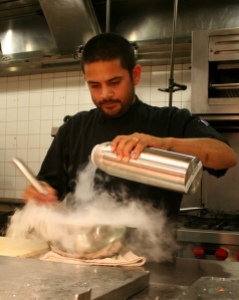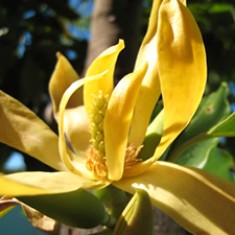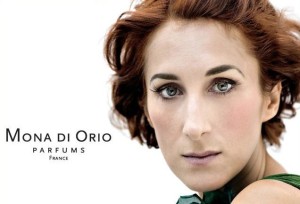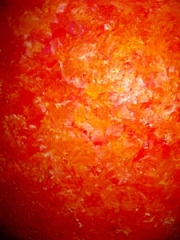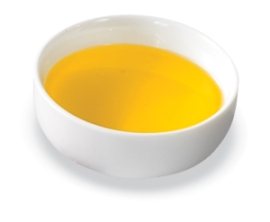The chef’s kitchen was airy and sparkling white, almost dainty at times. So too was his mise en place: small crystal bowls filled with ylang-ylang, a silver tray covered with the finest Madagascar vanilla bean pods, and a large pile of cedar. He began with the vanilla pods, slicing them horizontally, scooping out the tender flesh inside and grinding it to a thick paste. He added some butter, a few yolks and gallons of cream, then whipped the whole thing into the airiest custard possible. Nay, actually, by the time he finished, it was more like a vanilla custard mousse, flecked with bits of the black bean pod.
The chef was a talented man who believed in invention and originality in his food, so he turned his attention to the ylang-ylang. It was a rich, buttery, heady flower that felt very yellow to him. So he ground it down into an emulsion filled with a few pinches of butter. He thought it would bring out the flower’s intrinsic nature. He took the emulsion, folded it into the vanilla mousse and then set about for the twist: he whipped in the lightest pinch of black pepper, and covered the whole thing with a veil of white, confectioner’s powder. With great care, he placed the bowl of powdered vanilla-ylang-ylang mousse over a smoker filled with cedar chips. As he set fire to the wood, its delicate smoke wafted up into the air. The chef added a glass dome over the contraption, trapping the smoke and letting its delicate tendrils seep into the powdered, floral, vanilla custard mousse. Phase One was complete.
Phase Two was almost a completely separate affair. About three hours after the frothy, airy smoked-infused mousse was finished, when all the powder had vanished, and only woody elements really remained, he waved his culinary magician’s hand over the creation and turned it to amber. He would never reveal his secret of how he made his dessert suddenly turn into something very different — far from the almost Guerlainade-like opening with its dainty vanillic powder and the unexpected cedar smoke atop that airy, custard mousse — but it was different.
 Suddenly, it was ambered, golden-bronze, dryer, smokier, spicier, and with a surprisingly unexpected undertone of nutty hazelnut. Or was it actually a light dusting of marron glacé? Whether it was glazed chestnuts or toasted hazelnuts, he would never tell, but everyone who tasted his ambered vanilla wondered. Their greatest surprise, however, was the complete disappearance of the powder, to be replaced by something that would have been boozy had it not been so gauzy and lightweight. It didn’t matter — they liked it. Even the critic who normally despised anything with a gourmand character liked it. Not enough perhaps to go out and actually buy it, but the critic would absolutely eat it again if it ever fell into his lap.
Suddenly, it was ambered, golden-bronze, dryer, smokier, spicier, and with a surprisingly unexpected undertone of nutty hazelnut. Or was it actually a light dusting of marron glacé? Whether it was glazed chestnuts or toasted hazelnuts, he would never tell, but everyone who tasted his ambered vanilla wondered. Their greatest surprise, however, was the complete disappearance of the powder, to be replaced by something that would have been boozy had it not been so gauzy and lightweight. It didn’t matter — they liked it. Even the critic who normally despised anything with a gourmand character liked it. Not enough perhaps to go out and actually buy it, but the critic would absolutely eat it again if it ever fell into his lap.
The chef’s tale is really the tale of Mona di Orio‘s Ambre, a surprising perfume that perhaps doesn’t warrant the name “Amber” for the full first half of its development but which I liked quite a bit. It is an extraordinarily easily, wearable perfume that traverses from being a slightly modern twist on Guerlainade — Guerlain’s signature of vanillic powder that is at the base of all their classic perfumes — to a completely different end of the spectrum. In a way, it’s almost as if Mona di Orio has upended the usual Guerlain pyramid that traditionally starts with one thing and ends with vanilla powder. This is the complete reverse. And, at all times, it’s light, airy, almost frothy and cheerful, with unexpected twists of cedary smoke, bits of pepper, and then, later, boozy amber whipped into gauzy air.
 Ambre was released in 2010 as part of Mona di Orio‘s Les Nombres d`Or Collection. It is an is an eau de parfum, though Luckyscent and Fragrantica both erroneously list it as an eau de toilette. The company categorizes it otherwise and, naturally, we’ll go with their designation. Mona di Orio’s website describes Ambre as follows:
Ambre was released in 2010 as part of Mona di Orio‘s Les Nombres d`Or Collection. It is an is an eau de parfum, though Luckyscent and Fragrantica both erroneously list it as an eau de toilette. The company categorizes it otherwise and, naturally, we’ll go with their designation. Mona di Orio’s website describes Ambre as follows:
As delightfully sensual as bias-cut silk, Ambre draws you in to its world with curls of smoky amber. Cedar draws you further into the mystery while vanilla adds a slightly sweet resinous kick that can’t help but delight. Ylang ylang adds a glaze of innocent soapiness to the Film-Noir aspects, but never completely obscures them; who would want to? Easily as at home, at a ball or an intimate evening out, Ambre manages to be both reminiscent of something from long ago yet as fresh as tomorrow, and always very, very French.
Its notes include:
Cedarwood from Atlas, Ylang Ylang from Comores, Benzoin, Tolu [amber resin], Absolu Vanilla from Madagascar.
The very first blast of Ambre on my skin is vanilla. Rich, concentrated, almost buttered, and very much like the paste that you scrape out of a black Madagascar vanilla pod. Immediately on its heels come the bucketfuls of the ylang-ylang. The flower’s similarly buttered, rich, almost banana-like nature feels almost velvety. When combined with the vanilla, result is the overwhelming impression of a thick vanilla custard — except this one feels so light, it might as well have been whipped into a mousse! The pairing of the two rich notes is prevented from being cloying or overly sweet by a heavy dose of cedar, adding a lovely, dry counterbalance to the perfume’s richness. It’s not peppery but, rather, more akin to tendrils of woody smoke. Amber is the last one on the scene, smelling like vanillic benzoin instead of anything thick, balsamic and molten like Tolu.
For my tastes, this is much more my sort of “vanilla” than Mona di Orio’s super-popular Vanille (also from Les Nombres d’Or collection) which I thought was painfully excessive in its buttered undertones and sweetness. Then again, I cannot abide gourmand perfumes as a general rule, and I rarely succumb to any vanilla fragrances to begin with. Perhaps the appeal of Ambre is that the vanilla is not meant to be the primary focus but, rather, second or third to the floral and woody notes; it falls much more in the oriental category than in any gourmand one. I know that when I think of Ambre, months from now, I will always think of it first and foremost as a vanilla perfume infused with florals and smoke, before having to remind myself about the amber.
I was musing on the issue of Ambre’s surprising appeal when, suddenly, less than three minutes in, I was hit by a huge wave of powder. It isn’t like makeup powder or talc but, instead, evokes a white veil of confectioner’s sugared powder suddenly blanketing my vanilla-ylang-ylang-smoke mousse. It takes over Ambre completely, dominating the top notes and leaving the ylang-ylang to peek up from underneath.
When the powder combines with the vanilla, the result calls to mind a riff on Guerlainade, the signature base for classic Guerlain perfumes. Here, it’s much tamer than in the old French classics, mostly due to the impact of the cedar. Though it seems completely non-existent in any individually distinctive way, the note’s effects are present in a certain dry, smoky woodiness at the base that alleviates that Guerlainade a little. Mona di Orio’s airiness is another difference which impacts the nature of the powder. In Guerlain perfumes, especially in its vintage beauties, the famous signature base can sometimes feel very heavy and plush. It’s also often marked by orris root which creates a makeup or lipstick impression. Here, however, the absence of the orris root — and the presence of the smoky wood in a perfume that is quite airy overall — shifts the Guerlainade-like note away from the full-on, traditional, makeup powder and to something much more modern. To me, it feels closer to confectioner’s powder with its sweetened nature, but I know others smelled only lipstick.
Less than fifteen minutes into Ambre’s development, it starts to shift a little, like a mousse that is starting to settle. Its sillage drops and the perfume softens. It feels incredibly floaty (to invent a word), hovering like gauze just an inch above the skin. The notes have blended into a perfect whole: powder-and-vanilla-custardy-mousse-with-florals-and-light-smoke. And it remains that way for quite a while, with only minor changes. Slowly, the vanilla feels less custardy and much lighter, while the powder element slowly starts to drop in prominence. The cedar with its light tinges of smoke begins to rise much more to the surface until, suddenly, three hours in, Ambre has completely changed. Now, it is smokier, dryer and with an unexpected booziness that definitely feels like the super-rich amber resin, Tolu Balsam. The powder has finally become less predominant, though it continues to mix and meld with the vanilla. In the background, subtle tinges of ylang-ylang adds some subtle, creamy, velvety richness.
For the most part, however, the impact of the powder and floral notes is minimal because Ambre has finally begun to match its name. Tolu Balsam is one of my favorite ambers because of its spicy nuance and its slightly smoky feel that, here, is further accentuated by the cedar. The wood, in turn, has shifted a little to reveal a tone that just almost, just barely, verges on peppered. And the whole thing sits atop a base of warm, cozy, rich vanilla infused by smoke. There are flickers of something interesting in that combination of Tolu and concentrated vanilla: nuttiness. There is definitely an undertone that calls to mind roasted hazelnuts with the smallest, faintest suggestion of marron glacé. The whole thing is extremely subtle, almost ghostly, especially given the strong vanilla note, but I found myself sniffing my arm in appreciation for its occasional flickers here and there. As a whole though, the perfume is primarily a vanillic-amber in nature.
I wish Ambre had remained that way for a while, but it didn’t. The lovely, spicy Tolu Balsam phase lasted just over two hours — and almost as a skin scent at that. Finally, about 5.5 hours in the perfume’s development, the drydown begins. It begins as a simple, vanillic, benzoin amber that has the smallest suggestion of woodiness and powder. It’s so sheer and light, you have to forcefully inhale at your arm to detect it. Finally, just short of the eighth hour, Ambre fades even more to become nothing more than a general, amorphous, woody-vanilla flicker.
Most people seem to classify Ambre as … well, an amber perfume. To me, and on my skin, it was primarily a vanilla. Not a gourmand vanilla, thank God, but definitely a vanilla. And I liked this “vanilla” significantly more than the perfumista favorite from Mona di Orio: Vanille. I truly couldn’t handle it, though I still recommend Vanille for those who enjoy sweet perfumes and want a non-traditional vanilla fragrance with a twist. My problem is that I cannot abide excessive sweetness. As a result, Vanille was too, too much, but — like Goldilock’s porridge — Ambre was the perfect balance with its floral, dry wood, and smoke notes. Taking the issue of relativity even further, as someone who worships potent, massively opaque, moltenly resinous Orientals, I find it well-nigh impossible to think of the perfume as an “Amber.” The strength of that vanilla absolute, even in the drydown phase, makes it the dominant note in my mind.
On that same scale, I have to rate Ambre as a very airy, gauzy fragrance. Others seem to agree, though the term a number of people use on Fragrantica and elsewhere is “silky” instead of “airy.” They also find the sillage to be, on average, very “moderate.” In terms of longevity, the largest amount of votes is for “moderate,” followed then by “long-lasting.”
The consensus seems to end there, however, as reviews for the perfume itself on Fragrantica are sharply split. One commentator, “Hélio Sérgio Rocha,” picked up on the two separate phases of the perfume, writing:
The opening is sweet, powdery and light. [¶] The Ylang Ylang gives a sweet floral aspect to this scent and i can feel some honey too.
Then this perfume gets smoky and silky itself. [¶] I do not see on it distinct phases on the ofactory pyramid, but I feel a combination of two different phases: a sweeter one; and darker another. […]
Funny how this scent starts with a luminous amber and ends with an resinous aspect, so dark, mysterious and smoky. [¶]
I felt i was wearing a silk made cloth as a second skin of mine … [Paragraph and format alterations are my own, due to length.]
Many share his feelings, writing about how Ambre is an incredibly “cozy,” warm, “spiced,” amber fragrance that was “refined and elegant,” or “heaven in a bottle.” (The word “cozy” comes up repeatedly.)
On the complete opposite end of the spectrum, however, are those who shudder at Ambre’s powder, finding it to be far too excessive and, as a result, a complete deal-breaker. One woman thought the opening smelled just like baby powder, though she really liked the spicy amber phase (where she, too, smelled a nut-like undertone). And a good portion of men found the perfume to be too feminine, with one writing that it was “not unisex at all in my mind.”
As noted above, I really didn’t find the powder note to be akin to makeup or lipstick, and on my skin, it was far from overwhelming. I don’t like a lot of powder, especially if it smells like makeup or, even worse, like baby powder, so I would tell you if I detected that on my skin. I didn’t. In fact, I actually liked the powder stage a little — perhaps because of the rich ylang-ylang-custard-vanilla-smoke combination underneath it. Plus, I truly believe that the dry, smoky cedar note (and the absence of orris root) prevents the perfume from being very much like lipstick. Nonetheless, I completely agree with much of the other comments about how the amber stage was more enjoyable in its cozy spiciness, and how Ambre leans quite feminine. I don’t think this is a perfume that anyone should purchase blindly.
While I myself would never buy Ambre, I would absolutely wear it if a bottle somehow fell into my lap. I’d wear it frequently, in fact, and for one simple reason: it’s an incredibly easy perfume. I can see this as fitting a wide variety of circumstances, but especially when you’re in a rush and want to spray something simple while you’re on your way out the door. Ambre is the furthest thing from revolutionary, complicated, or novel. It’s hardly a masterpiece, and isn’t even particularly interesting on some levels. But it’s one of those very practical, daily staple-like perfumes that could be a good workhorse scent for someone who would like a little cozy comfort, a little sweetness, and a good amount of vanilla (with light amber) and no gourmand tendencies. Unfortunately, I think a full bottle costs a damn sight too much at $230 for such a simple, staple scent. On the other hand, that price is for a large 3.4 oz/100 ml bottle, and there are much cheaper alternatives available in terms of travel sets and minis. Plus, as I always say, price is a very subjective, personal matter.
Perhaps the biggest problem is that Ambre is not a perfume that will drive people wild with enthusiasm and excitement. But we all need perfumes that are easy, breezy, simple basics; perfumes that you can just spray and go. If you can handle some powder (or, perhaps, a lot of powder?), then Ambre fits the bill nicely.


